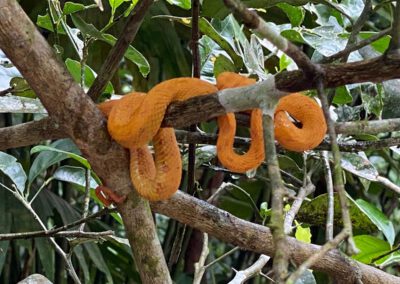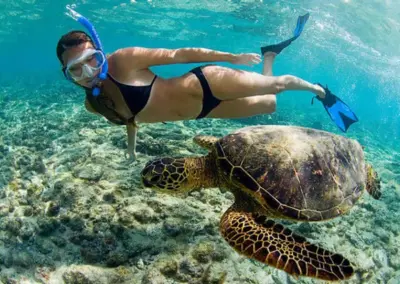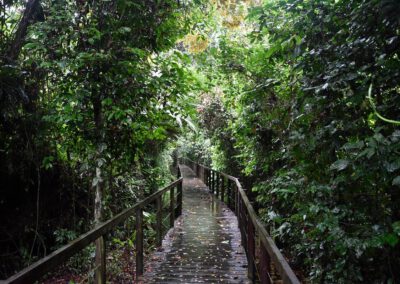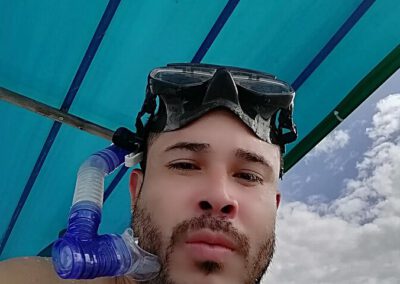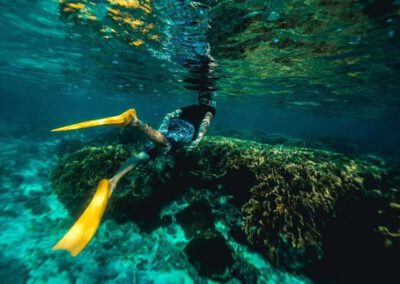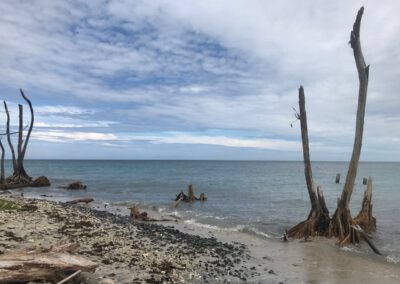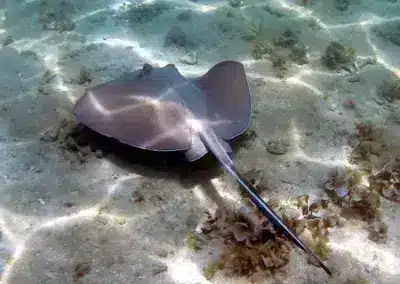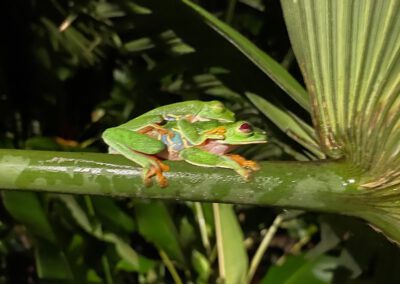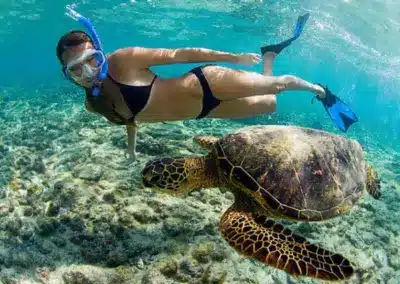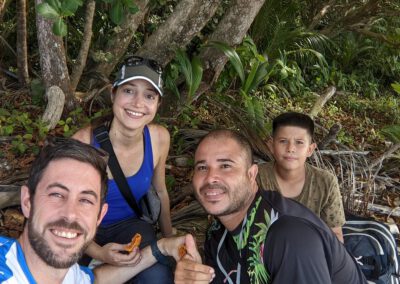Contents
- 1 Private Snorkeling Cahuita | Cahuita Park Hike – Vargas
- 1.1 Private Snorkeling Cahuita | Cahuita Park Hike – Vargas
- 1.2 Puerto Viejo Snorkeling Costa Rica at Vargas | Cahuita Park Hike
- 1.3 Puerto Viejo Snorkeling Costa Rica at Vargas | Cahuita Park Hike
- 1.4 Take your Camera – Make your Snorkeling Underwater Video Memory
Private Snorkeling Cahuita | Cahuita Park Hike – Vargas
Private snorkeling in Cahuita takes place at the Vargas site within the protected reef area of Cahuita National Park’s Marine Park. It’s a guided experience led by officially licensed snorkeling tour guides, and it offers access to breathtaking coral reefs.
Cahuita snorkeling at the Vargas site, conveniently located near Puerto Viejo and accessible by bus, is renowned as one of the finest snorkeling experiences in Costa Rica. Here, you’ll have the opportunity to immerse yourself in the captivating marine life of Cahuita National Park’s Reef at Puerto Vargas Marine Park.
This reef is widely regarded as one of the most picturesque in Costa Rica, boasting a rich tapestry of over 35 coral varieties and more than 100 species of tropical fish, as well as the occasional presence of turtles and even some sharks.
Following your snorkeling adventure, you can continue your journey with a hiking trip at the Vargas site of Cahuita National Park. Here, you’ll encounter a diverse array of wildlife, including monkeys, sloths, iguanas, lizards, snakes, and more. Don’t forget to take in the incredible flora, fauna, and the towering ancient trees that add to the park’s allure.
Private Cahuita Snorkeling | Vargas Cahuita Park Hike – What to expect?
The Starting Point is at 8:30 a.m. at the entrance of Puerto Vargas, at the parking lot next to the ranger station. The tour starts with a short route to the snorkeling hotspot of the Private Snorkeling tour from shore.
This part of the reef is less known, but it has astonishing reefs and is even more unaffected by the environment. It belongs to the east side of the Marine Park of Cahuita National Park.
We make two or three snorkeling dives from here for about 40 minutes. Afterward, you can enjoy the hike at the Puerto Vargas site of Cahuita National Park. It is a beautiful trip. This last part leads through an old rainforest with giant trees covered in Epiphytes while you walk over an elevated trail (blue morph butterflies fly by while you walk over a high course through a swampy forest).
This hike will allow you to fully experience the broad spectrum of biodiversity the park offers. There is a big chance we run into different kinds of mammals, like monkeys, coatis, sloths, snakes, and other wildlife.
The tour ends around 1 p.m. again at The Ranger Station of Puerto Vargas. Optional, we recommend this Private Snorkeling and Hike tour with:
• a visit to the Sloth Sanctuary
• visit to Cacou Trails at Hone Creek
These can be booked separately. In that case, we start with one of these visits, and after a break, we start with the Private Snorkeling tour and hike at the Puerto Vargas site of the Cahuita National Park and snorkeling at these protected reefs.
Duration
Approximately 4.5 hours [with 2 of 3 [upon group preference] sessions of about 40 minutes of snorkeling]. The rest of the tour is a short hike at the Vargas site of the Cahuita National Park.
What to bring with you
Sunscreen, swimming suit, towel, bottle of water, wind jack for the boat trip. For the hike, bug spray, suitable footwear, and, of course, your camera.
Our Tour guides
Our guides are genuinely local and experienced tour professionals. They harbor a sincere and profound passion for nature and wildlife, deeply respect Costa Rican culture, are thoroughly prepared, and are licensed by the ICT (Costa Rican Tourism Institute).
Experienced licensed snorkeling guides with 10+ years of experience as park guides will make this trip.
Pricing
For pricing, see the shop product page and the “Additional Information” Tab; minimum group size [adults] = four persons. Private snorkeling is possible with 2 or 3 persons; see the product page.
What is included
The use of snorkeling gear, fresh fruits, a local, experienced private snorkeling and park tour guide, and the obligated entrance fees at the Puerto Vargas ranger station.
Meeting Point and Directions
The parking lot at the Entrance of Puerto Vargas – just before the Puerto Vargas Ranger Station. If you come by Public Transport, take the bus stop at Puerto Vargas [in front of the Vargas Entrance of the Cahuita National Park].
About Puerto Vargas | Cahuita Park
The Park is situated along the southern coast of the Caribbean in Costa Rica, dating back to 1978. Cahuita National Park features two entrances, and the Private Snorkeling Tour takes place on the Vargas site, the most picturesque side of the Marine Park.
This snorkeling experience is eco-friendly and conducted from the shore. Visitors entering the Puerto Vargas entrance must pay an obligatory entrance fee at the Ranger Station.
These contributions are vital in keeping the park’s pristine condition, ensuring it remains free from pollution, and safeguarding the well-being of its wildlife and visitors.
Puerto Vargas offers a distinct ecological experience compared to Cahuita, featuring unique flora and fauna. The swamp forest, with its ancient trees and diverse birdlife, makes it a worthwhile destination.
The terrain is more solid in these forested lowlands with inadequate drainage than in the marshy Ravi swamps. Here, you’ll encounter wooded swamps featuring buttressed Pteropus trees and a variety of palm species, all adorned with numerous lianas. This habitat is home to the Green Ibis, Rufescent Tiger-Heron, and Green-and-rufous Kingfisher.
Much of the ground in this evergreen swamp forest remains submerged most of the year. Decomposing vegetation and limited drainage contribute to the accumulation of tannins, giving rise to the distinctive ‘Backwaters.’
Fortunately, a lengthy elevated footpath has been constructed above the forest floor, offering a unique and immersive way to explore this Neotropical rainforest.
Our tour guides offer an array of exciting experiences, including adventurous outings, nature encounters, and hiking and trekking tours.
Wildlife Cahuita Park | Puerto Vargas
The National Park of Cahuita boasts a rich and diverse array of wildlife species. Among the more commonly encountered mammals in the park, you’ll find armadillos, raccoons, sloths, howler monkeys, and capuchin monkeys. The park is also home to a variety of reptiles and amphibians, including blue jeans dart frogs, red-eyed-leaf frogs, green iguanas, whip-tailed lizards, green vine snakes, and boa constrictors.
One of the most remarkable reptiles you may come across is the yellow eyelash pit viper, characterized by its striking golden-yellow hue. The avian population within the park is equally impressive, with residents such as keel-billed and chestnut mandible toucans, fiery-billed aracaris, oropendolas, parakeets, parrots, herons, egrets, and an array of other bird species.
Private Snorkeling Peurto Viejo [near] at Puerto Vargas
The reef within Cahuita National Park enjoys protective status and can only be explored in the company of authorized tour guides holding permits.
This reef holds the distinction of being the largest fringing reef within the Caribbean, specifically within Costa Rica. One of its noteworthy features is its extensive coverage, spanning more than 500 acres of coral reef.
The Cahuita Reef is structured into three distinct barriers: the outer barrier extends for a remarkable 3 miles, running from the western side of Punta Cahuita to the eastern side, and it maintains a separation from the coastline ranging from 100 meters to 1.5 miles.
Situated between this outer barrier and the coast is a smaller fringing reef, measuring approximately 0.5 miles in length and situated within 100 meters of the shoreline, aptly referred to as the inner crest. Additionally, at the western edge of the reef, there exists a 100-meter barrier. The lagoon area also houses patch reefs and carbonate banks further offshore.
This reef serves as a vital nesting site for sea turtles, but it offers much more than that for those who venture into scuba-diving or snorkeling expeditions. Within the Cahuita Reef, a diverse marine community thrives, featuring over 240 species, including tropical fish varieties, sea urchins, sea cucumbers, mollusks, and crustaceans.
Best Snorkeling in Costa Rica, First of top 3 Reefs of Costa Rica
Despite recent shrinkage, the reef remains one of Costa Rica’s foremost marine attractions. When it comes to snorkeling, Cahuita is indisputably the top-rated destination in Costa Rica.
If you’re keen on snorkeling in Puerto Viejo or its vicinity, Cahuita is the ideal choice.
Coral reefs owe their existence to living organisms known as corals. These creatures possess calcium carbonate skeletons and form symbiotic relationships with algae, which generate sustenance through photosynthesis.
Coral reefs are among the world’s most productive ecosystems, serving not only as carbon sinks but also as crucial breeding grounds for marine life.
Costa Rica boasts coral reefs on both its coastlines, with the most developed ones situated on the South Atlantic coast, spanning from Moín to Punta Mona, covering approximately 10 square miles.
Cahuita National Park safeguards the Caribbean coast’s most remarkable coral reef and has been a focal point of extensive research.
Indeed, the Cahuita National Park boasts the largest fringing reef in the Caribbean within the country.
Over the past three decades, the Cahuita Reef has experienced degradation due to factors such as siltation, various human-induced impacts, and natural events exacerbated by human activity, including significant organism die-offs, earthquakes, and temperature increases.
Nonetheless, despite these challenges, the Cahuita Reef remains a stunning natural wonder. Thanks to its protected status, you can still encounter 35 distinct coral species here, including the vibrant light yellow brain coral, the impressive elkhorn coral, and the striking blue staghorn coral.
Marine Life Puerto Vargas | Cahuita National Park
Marine life, also known as sea life or ocean life, encompasses a diverse array of plants, animals, and other organisms inhabiting the saltwater environments of the sea, ocean, or coastal estuaries.
At its core, marine life plays a crucial role in shaping the Earth’s environment. Aquatic organisms, especially microorganisms, contribute to oxygen production and carbon sequestration.
Additionally, marine life significantly influences and safeguards coastlines, with certain marine organisms actively participating in land formation, such as coral-building reefs. Many life forms originally evolved in marine habitats.
In terms of volume, oceans account for approximately 90% of the planet’s habitable space. The earliest vertebrates appeared as fish, exclusively adapted to aquatic life. Some of these fish eventually evolved into amphibians, which can thrive both in water and on land.
From this group of amphibians emerged reptiles and mammals, and certain subsets of each returned to the ocean, becoming sea snakes, sea turtles, seals, manatees, and whales. Various plant species, including kelp and algae, thrive in underwater ecosystems and serve as the foundation for certain marine habitats.
Plankton, particularly phytoplankton, forms the essential base of the ocean food chain. Marine invertebrates have developed numerous adaptations to survive in oxygen-deprived waters, including breathing tubes, as seen in mollusk siphons.
Fish possess gills instead of lungs, though some species, such as lungfish, have both. Marine mammals like dolphins, whales, otters, and seals require periodic surfacing to breathe air.
The Cahuita Reef, for instance, boasts an impressive diversity of marine life, including over 500 fish species and three shark varieties that can be encountered during snorkeling excursions. Explorers can also encounter numerous other marine species, such as dolphins, stingrays, blue parrotfish, angelfish, manta rays, rock beauty, the French angelfish, and even the potentially dangerous scorpion fish.
Cahuita Snorkeling and encounter with Turtles | near Puerto Viejo Snorkeling
The most prevalent sea turtles found in Costa Rica include Leatherbacks, although they are relatively rare in the Cahuita area, primarily seen on ‘Big Beach.’ More commonly, visitors will encounter Hawksbill turtles, known locally as ‘Carey,’ and Green Turtles, both of which nest along the Caribbean coast.
Hawksbill turtles nest in Cahuita National Park between September and January, with hatching occurring roughly from January to March.
While embarking on a snorkeling expedition, there is a high likelihood of encountering these fascinating marine creatures.
Cahuita boasts its own rescue center dedicated to promoting the protection and preservation of sea turtles. This center serves as a guardian of native wildlife in the region, ensuring the survival of sea turtles and the safeguarding of its natural treasures.
The Turtle Rescue Center in Cahuita collaborates with volunteers from the local Cahuita community and biologists. It is well worth a visit. Our tour guides are enthusiastic about providing directions or even accompanying you to showcase the vital work carried out by this foundation. We consider ourselves an integral part of the ecosystem and the stewards of its delicate balance.
Private Snorkeling Cahuita | Cahuita Park Hike – Vargas


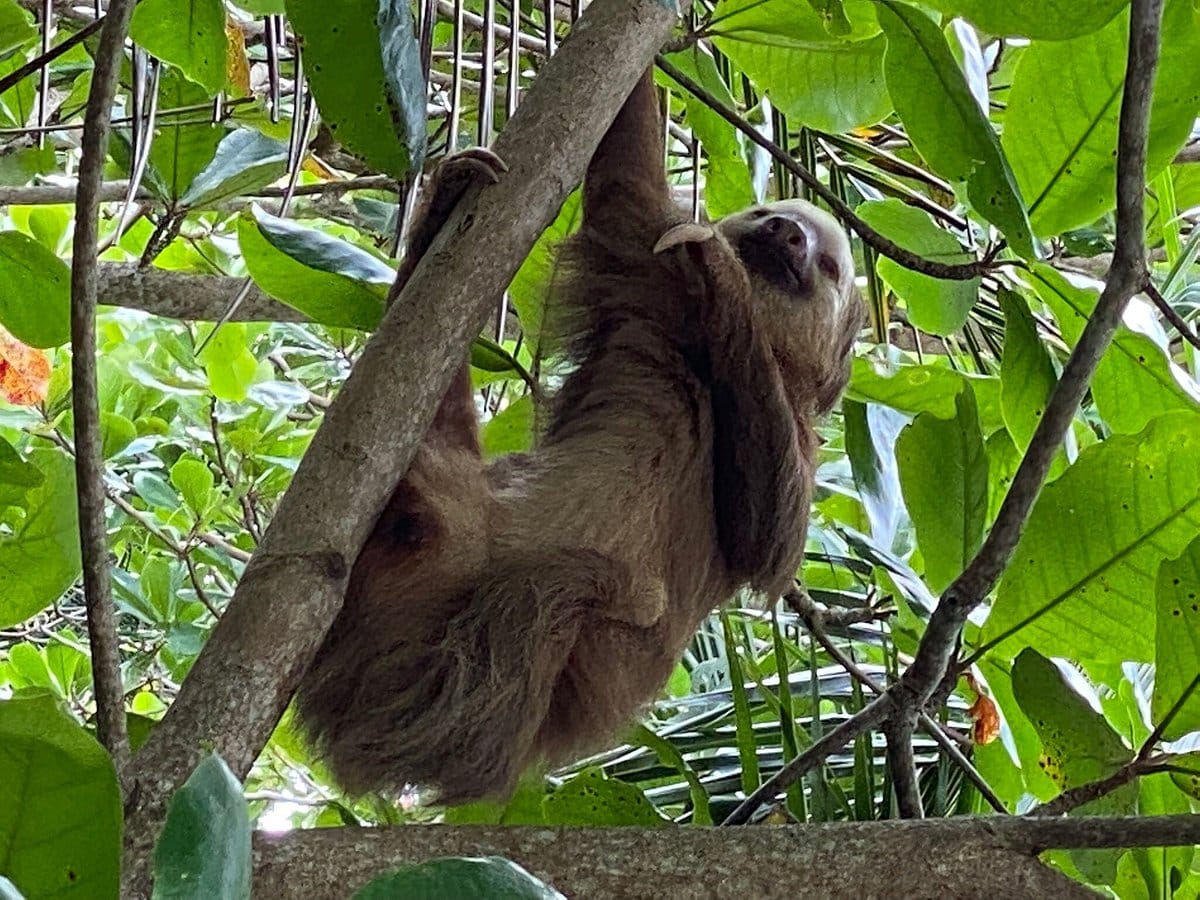
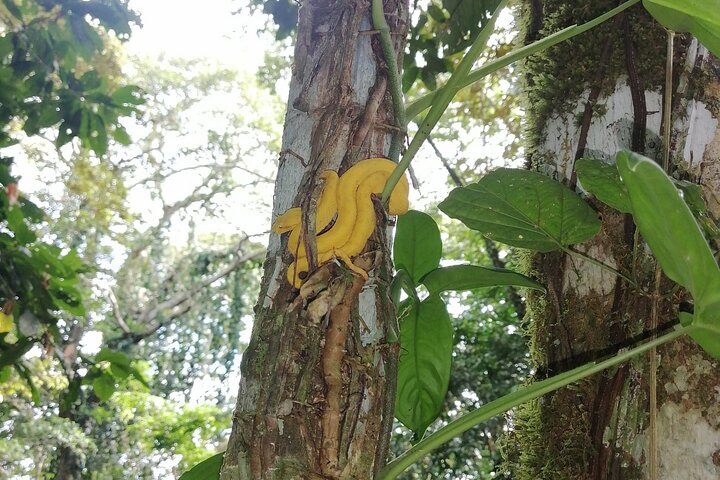
Take your Camera – Make your Snorkeling Underwater Video Memory
A video recorded by an adventurous traveler during a full-day combo tour, encompassing both snorkeling and hiking, within the breathtaking Cahuita National Park. The footage showcases the protected coral reef of Costa Rica, highlighting why snorkeling in the Marine Park of Cahuita is renowned as the premier snorkeling destination in the country.



